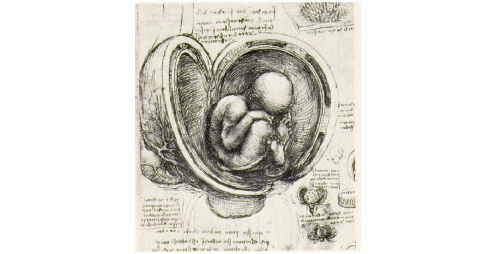Dette dokument er flaget "Muligt forældet"
Find siden via vejledninger
Hydrops fetalis (nonimmune) and fetal ascites
2008
- Main and Danish guidelines by the web master
|
Hydrops is excess of fluid in more than one body cavity or one exudates and subcutaneous edema. Incidence 1/1500 to 1/4000
Appears normally in the following sequence: Polyhydramnios, ascitis (first between bowel loops along the abdominal trunk or within the pelvis). Pleural and pericardial edema, placenta edema (> 4 cm) and edema of the skin (> 5 mm). Pathophysiology: Decrease plasma osmotic pressure, (lever damage or disease) increase capillary permeability (heart failure),obstruction of venous and/or lymphatic flow, and volume overload (twin-twin transfusion). Causes: Hydrops Secondary to isoimmunization (see page 96 82). Non-immune Hydrops. Genetic Most common aneuploidi (10%). Turnes Syndrome), (trisomy (21, 18 and 12) and triploidy : Cardiovascular abnormalities: 40% Congenital heart disease e.g. Hypoplastic left heart, AVSD and isolated ventricular and septal defect. Recurrent risk of congenital defect 2-5%. Arrythmia: 5% Both tachy- and bradyarrythmias e.g. Super ventricular tachycardia or less common paroxymal tachycardia, WPS Syndrome, fetal hyperthyreodism from transplacental passage of TSH receptor stimulating antibodies, congenital block (structural and neonatal lupus, see page 65). Vascular abnormalities e.g. chorioangiomas of the placenta > 4 cm Infektions 5-10% have infektions. Parvovirus B-19, Cytomegalovirus, Adenovirus, Syphilis, Coxsackievirus. More rare: Herpes, listeria, chlamydia, rubella, respiratory syncytial virus, influenza B. Twin-twin transfusion: 10% of monochorionic twins Lung 5% e.g.: adenomatoid malformation, diaphragmatic hernia Intestinal: < 5%. Meconium perforation, bowel obstruction Renal: < 5%. e.g. severe uropathy causing urinary ascitis Skeletal dysplasia: 2-5% Most syndromes have marked thoracic restriction. Over 20 types of dysplasia has been described. Fetal akinesia syndrome: 2-3% e.g. lethal multiple pterygium syndrome, arthrogyposis multiplex congenital, Neu-Laxova syndrome, Pena-Shoiker syndrome and myotonic dystrophy. Genetic disease: 10% Metabolic disease e.g. lysosomal storage disorders, Gaucher multiple malformation syndrome. Fetal anemia 10-25%) (alpha-Thalasemia, red cell enzyme disorders like glucose 6 phosphatase deficiency). Diagnosis Maternal history, maternal blood group and antibodies screen, full blood count, Kleihauer-test, VDRL, virology (parvo-cytomegalo-adenovirus-caxasackecvirus and toxoplasmosis), TORCH. Fetal blood sampling, karyotyping, fetal blood for anemia, full blood count, blood group and direct Coombs' test, viral IgM, parvovirus, cytomegalovirus DNA karyotype. Ultrasound scan for malformation, and Doppler middle cerebral artery for detection of severe anemia. Amniocentesis for karyotype, cytomegalovirus DNA. Prognosis depends on the course, if unexplained, perinatal mortality 30-90%. Maternal complications Mirror Syndrom refers to generalised material edema, often with pulmonary involment, that "mirrors" edema of the fetus and placenta. May present as edema, shortness of breaths or uncontrolled hypertension with clinical presentation to that of preeclamsia (but often low hematrocit) References: (1) Bukowski R, Saade GR. Hydrops fetalis. Clin Perinatol 2000 Dec; 27(4):1007-31. (2) Twining P, McHugo J, Pilling DW. Textbook of Fetal Abnormalities. Churchill Livingstone. An imprint of Harcourt Publishers Limited, 2000. (3) UpToDate 2007, Online 13.3
Feel free to mail me |
